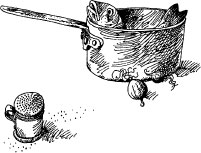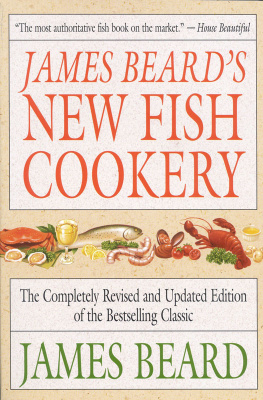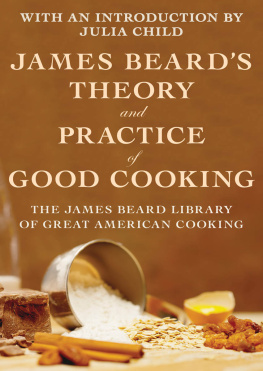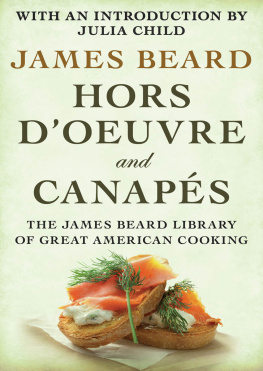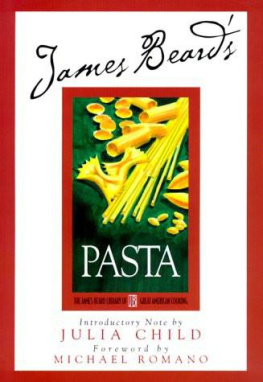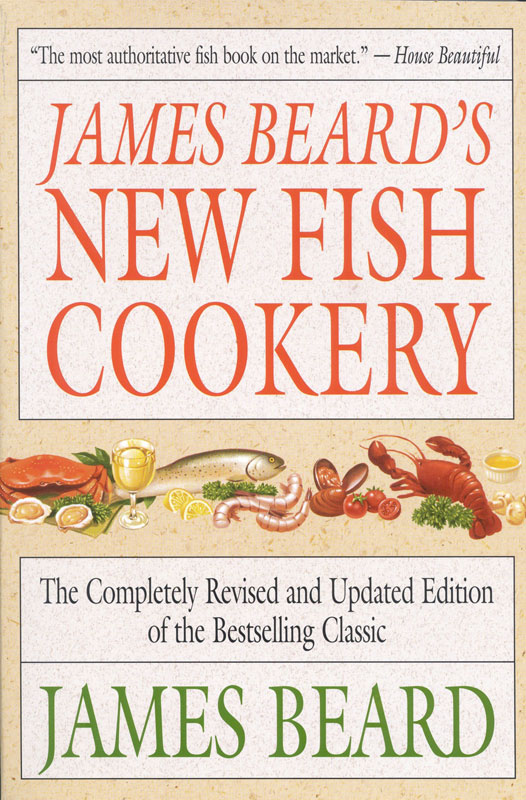COPYRIGHT 1954, 1976 BY THE ESTATE OF JAMES A. BEARD ALL RIGHTS RESERVED. NO PART OF THIS BOOK MAY BE REPRODUCED IN ANY FORM OR BY ANY ELECTRONIC OR MECHANICAL MEANS INCLUDING INFORMATION STORAGE AND RETRIEVAL SYSTEMS WITHOUT PERMISSION IN WRITING FROM THE PUBLISHER, EXCEPT BY A REVIEWER WHO MAY QUOTE BRIEF PASSAGES IN A REVIEW.
The author is grateful to E. P. Dutton & Co., Inc., for permission to quote the recipe for roasting a pike from The Compleat Angler by Izaak Walton, Everymans Library Edition; and to Charles Scribners Sons for permission to reprint Minorca Gopher Stew from Cross Creek Cookery by Marjorie Kinnan Rawlings. Copyright 1942 by Marjorie Kinnan Rawlings.
Hachette Book Group
237 Park Avenue
New York, NY 10017
Visit our Web site at www.HachetteBookGroup.com.
Little Brown and Company and the logo are trademarks of Hachette Book Group
First eBook Edition: February 2009
ISBN: 978-0-316-06980-9
JAMES BEARDS NEW FISH COOKERY
The most authoritative fish book on the market.
House Beautiful
MORE CULINARY COUPS IN THE JAMES BEARD TRADITION OF COOKING EXCELLENCE
More than 500 recipes for 85 different kinds of shellfish, saltwater, and freshwater fish.
How to create a taste-tempting variety of fish stews and chowders.
How to whip up 48 flavor-enhancing sauces and savory stuffings.
How to prepare some lesser-known, highly flavored varieties of fish.
How to find the best fresh or frozen fish on the market.
A must for any good cooks collection.
Dallas Times Herald
Unsurpassed for practicality and quality recipes. His updated information on cooking methods for fresh and frozen fish and seafood and his advice about wine are particularly good.
Milwaukee Journal
This excellent cookbook not only contains a multitude of wonderful recipes for cooking fish, but the directions are so clear that even a neophyte can follow them easily.
King Features Syndicate
A definitive cookbook tested with unqualified success in Mr. Beards own kitchens and cooking classes.
Christian Science Monitor
Beard on fish should be on every cookbook shelf. Old hands will want the new edition, novices will find it explains what they need to know about salt and freshwater fish, shellfish, even frogs legs and terrapin.
Publishers Weekly
In this are all the answers most of us will ever need for any kitchen fish confrontation.
Cincinnati Post
Books by James Beard
Hors dOeuvres and Canaps
Cook It Outdoors
Fowl and Game Cookery
The Fireside Cookbook
Paris Cuisine (with Alexander Watt)
Jim Beards New Barbecue Cookbook
The Complete Book of Outdoor Cookery
(with Helen Evans Brown)
How to Eat Better for Less Money
(with Sam Aaron)
The James Beard Cookbook
James Beards Treasury of Outdoor Cooking
Delights and Prejudices
Menus for Entertaining
How to Eat (and Drink) Your Way Through a French
(or Italian) Menu
James Beards American Cookery
Beard on Bread
Beard on Food
James Beards New Fish Cookery
This rich land of ours is richer still because of the living things that swim or crawl in its waters. In the seas and gulfs along our shores, in our innumerable lakes and ponds, and in our rivers and lesser streams are hundreds of different sorts of edible fish and shellfish. Yet I suppose that of this great variety the average American has cooked no more than three or four kinds. Few people have tasted all the species that are sold in our markets. Many Americans eat fish regularly without really knowing what fish they are eating.
For centuries the French, Italians, Russians, and Chinese have been great fish cooks. It is regrettable that skill in cookery is not an inherited trait among human beings, and that the art of preparing fish could not have been transmitted effortlessly from Old World generations to those of the New. But then, of course, there would have been no need for this book, the purposes of which are to encourage Americans to eat more fish and to help them enjoy it more through the expedient of cooking it well.
All my life I have been fond of fish, and I have been fortunate in having lived where fish were plentiful. I was brought up in the Pacific Northwest, a region that is remarkable in its range of both salt- and freshwater fish. Later, in California, New York, and Europe, I managed to eat every form of seafood I could catch or buy.
Nearly all the recipes I offer were tested at one time or another in my own kitchen. Through the years I have had much expected pleasure and many exciting surprises in cooking varieties of fish that were new to me, in trying new recipes, and in refining traditional ones. I urge you to be adventurous, as I have tried to be, in your approach to fish cookery. And I suggest only one general rule: Dont overcook fish.
JAMES A. BEARD
Since I first wrote this fish book, there have been great ecological changes, and there have been great shortages of some of our favorite fish. There will continue to be, I am afraid, until many of the problems that have to do with raising, caring for, and harvesting fish are settled. Some of our shellfish are almost extinct. Some of our favorite fish are in short supply. On the other hand, there are fish being used and publicized which we never dreamed of using before that have rather distinct and varied flavors that we have not experienced. It is wise to acquaint yourself with those fish in your markets that are permanently in short supply nowadays and those that are in fairly plentiful supply, because one can then judge what will be your mainstays in fish for the future.
In New England there is still haddock, cod, scrod, lemon sole, and small sole. Around New York, we have the same fish, plus a great plenitude of striped bass, and we also get red snapper, pompano, trout, salmon, and halibut. Along the Atlantic Coast, you will find very much the same things. There are shortages of crab and of lobster, but so far no shortages of shrimp and scallops, especially bay scallops, which seem more or less at a premium.
On the West Coast, I think you will still find the dabs, the rex sole, and the petrale sole; in the Northwest, the ling cod, true cod, sablefish, to some extent the sturgeon and the sea trout, and what is known on the West Coast as red snapper, which differs from that on the East Coast. In the rivers and lakes there are no tremendous shortages, though I dont think fish are quite as plentiful as they once were. Yet the variety seems to continue in its satisfying way. We are using many fish now that were not in common usage before, such as squid and octopus, and various other smaller fish. As the science of aquaculture develops, we can look forward to increased varieties and to new flavors from the sea that are totally alien to us now.
It is with a certain sense of excitement, and a certain sense of loss, that I look to the future in fish cookery. I hope the revisions in this book will assist you in adapting to the new tastes we will all have in the coming years.
We wish to thank the Canadian Fisheries Council for their revolutionary discovery in fish cookery. And thanks to Carl Jerome for retesting a major portion of the recipes. Also, I will grant kudos to Emily Gilder and Marilyn Mangas for their assistance with the manuscript of this book. Our thanks to Marc Parson for his suggestion that inspired the addition of a section to the book.
